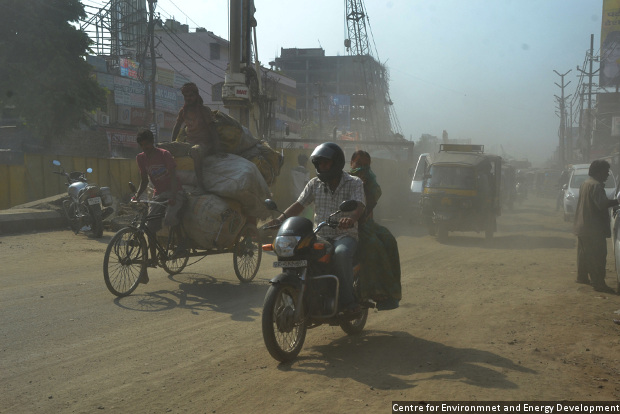After 2010, India’s Air Deteriorated Faster Than Ever
India’s air quality deteriorated faster than ever over five years to 2015, compared to the period before 2010, according to the State of Global Air 2017 report, recently released by the US-based Institute of Health Metrics and Evaluation (IHME), an independent global health research organisation.
The report also said a million Indians die from the effects of air pollution every year, a link that the government has rejected.
Although the rate of death and disability adjusted life years (DALY) has been reducing at more than 1% a year (as we explain later) in India, the indicators slowed between 2010-15, indicating a rise in air pollution over the period stalled improvement, according to our analysis of IHME data.
Deaths per 100,000 population in India due to air pollution reduced from 165 in 1990 to 135 in 2010, according to the IHME data.
But, the rate remained almost the same in the five-year period under consideration: 2010-15.
Source: State of Global Air 2017; *Average annual population-weighted PM 2.5 concentration
India has better air quality than Saudi Arabia and Bangladesh, but its air quality is about 50% worse air than China, two times worse than South Africa and five times worse than the United Kingdom.
In the six countries considered for analysis, India reported the worst deaths-per-population ratio: 135 dead per 100,000 people.
Source: State of Global Air 2017; *Average annual population-weighted PM 2.5 concentration
Note: The five countries were chosen for analysis on this basis; China: Fastest developing country along with India; Saudi Arabia: Worst polluted air; South Africa: Part of BRICS, a developing country; United Kingdom: Developed country; Bangladesh: Subcontinental neighbour
As the chart explains, air quality in Saudi Arabia has been improving since 2010, at a rate faster than the rate of deterioration in India.
Air pollution due to particulate matter—fine particles made up of oxides of sulphur, nitrogen and carbon—especially PM 2.5, is the fifth biggest killer in the world, after the diseases related to the heart and diabetes, according to the IHME report.
PM 2.5 refers to particulate matter known to pose the greatest threat to human health, smaller than 2.5 micrometers, or roughly 1/30th the thickness of a human hair. These particles can be inhaled deep into the lungs, causing heart attacks and strokes, which account for three-quarters of 3.3 million deaths–including 645,000 in India–every year globally, according to this 2015 study from Harvard University.
Deaths And Healthy Years Lost Reduce, But Slowly, 2010-15
Source: State of Global Air 2017; *Attributable to PM 2.5; **Per 100,000 population, attributable to PM 2.5
Healthy years lost due to polluted air in India reduced from 4,138 per 100,000 population in 1990 to 3,022 in 2010, only to remain near constant till 2015 (2,922).
How Health Indicators In Select Countries ChangedOver 25 Years
Source: State of Global Air 2017; *Attributable to PM 2.5; **Per 100,000 population, attributable to PM 2.5
Even in terms of healthy years lost, India fared worst amongst the six countries.
India rejects report findings, acknowledges growing air pollution
The report’s findings--specifically the estimate of a million deaths every year--were rejected by India’s environment minister Anil Dave on February 22, 2017.
“There are many serious institutions in India—NGOs, government organisations—which do research on this issue,” said Dave. “And a proud country always trusts in its own data and takes action on that. (Controlling) air quality is not rocket science. What state governments and local bodies have to do, they have been told a number of times. In the future as well they will be told.”
However, Dave’s ministry has no studies that link air pollution to death and disability, his officials acknowledged to Mint.
What is not in question is that India’s air quality is deteriorating, with even the environment ministry releasing on February 21 a list of 94 Indian cities with poor air quality.
86% of extreme pollution in Indian subcontinent and China
About half of the global population lives in areas with PM 2.5 concentrations above the World Health Organization (WHO) interim target (35 µg/m3), but “nearly all (86%) of the most extreme concentrations (above 75 µg/m3) were experienced by populations in China, India, Pakistan, and Bangladesh”, the report said.
The numbers indicating PM 2.5 are population-weighted average concentrations for 2015--that is, the PM 2.5 concentration for India is the average of PM 2.5 concentrations at different locations, weighted according to the population.
For example, the population-weighted average of a concentration of 100 µg/m3 in Delhi with 20 million people and 50 µg/m3, say, in Mumbai with 10 million people is not 75 [(100+50)/2], but 83.3 [((100*20)+(50*10))/(20+10)].
Geographically, air was the most polluted in Qatar (107 µg/m3), Saudi Arabia (106 µg/m3), and Egypt (105 µg/m3). But dust, rather than human-induced factors, plays a major role in polluting the air in this part of the world, as it is a desert.
In India, and across the rest of the subcontinent, air pollution is largely caused by human-induced factors like smoke from burning of farm residues, vehicles and power plants, IndiaSpend reported in October 2016.
Worldwide, deaths due to polluted air increased 40% in three years--from 3 million in 2012 to 4.2 million in 2015,
PM 2.5 levels rose 11.2% from 39.7 microgram per cubic metre of air (µg/m3) in 1990 to 44.2 µg/m3 in 2015.
Unlike developed countries, where healthy years are lost in the 60+ age group, polluted air affects the 15-44 age-group the most in developing nations, a 1997 World Bank study found.
We welcome feedback. Please write to respond@indiaspend.org. We reserve the right to edit responses for language and grammar.
__________________________________________________________________
“Liked this story? Indiaspend.org is a non-profit, and we depend on readers like you to drive our public-interest journalism efforts. Donate Rs 500; Rs 1,000, Rs 2,000.”



